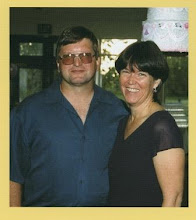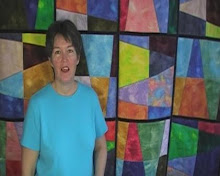 Do you ever get up from sewing and quilting and stretch, creak and groan, feeling uncomfortable and tired? It's very possible that it isn't from your project, it's your sewing table and chair!
Do you ever get up from sewing and quilting and stretch, creak and groan, feeling uncomfortable and tired? It's very possible that it isn't from your project, it's your sewing table and chair!
Being comfortable while sewing and quilting is more important than your sewing machine, tools, fabrics or threads because you can have the best equipment in the world but if you are in pain or straining when using them you won't be able to sew or quilt for very long! Your body may be sending messages to your brain saying "no more sewing" because of that strain and yet you want to sew!
Ergonomic comfort is often completely overlooked, especially when we don't have a dedicated sewing area. I often hear or read about a quilter "taking over the dining room table" and it makes *my* back hurt just reading those words!
The important ergonomic factors of sewing in comfort are:
1. Height of your sewing table. A dining room table average height is 29-30 inches high, which by itself is too high for comfortable sewing, and when you add the base of the sewing machine, about another 3 inches (bringing the height up to 33") , the proportions are totally wrong. Just that small bit of difference can create strain and pain throughout your body. Here's what OSHA (US Gov't Occupational Safety & Health Administration) has to say about Sewing Stations.
2. Notice that number one on their list is height of the chair. I put it at number two because it can be easier to change than table height. An adjustable chair is a must for sewing! Here's what the Center for Disease Control has to say about chairs:
"Contrary to popular belief, sitting, which most people believe is relaxing, is hard on the back."3. Position of the sewing machine. Many sewing cabinets (if your machine is in one) position the machine too close to the body, and the sewing head is "off center" to your body, putting shoulders and arm muscles in a strained and awkward position.
More about Ergonomics from Wiki ...
SOLUTIONS!
Table height: I do not advocate cutting the legs off your dining room table (unless you want to) but I do strongly advocate getting or using any other table than your dining room table for sewing. Some quilters turn a small bedroom closet into a sewing area, with a board or shelf inserted to serve as the sewing machine support. I use portable tables that have height adjustable legs ($42). Certainly an investment in your comfort is worth it! Make sure that when your machine is set up that you have a 90 degree or slightly greater angle at your elbow. You should not be "reaching up" to sew. My sewing machine bed is 27" high and I am 5'6" tall. Petite women are especially vulnerable to the agonies of mis-proportion for their sewing machines.
Your chair is your best friend when sewing! More than your seam ripper! Okay, a seam ripper is nobody's best friend but you know what I mean. A height adjustable chair is the best investment you can make (the kind for office work). Your feet should be flat on the floor but if you cannot manage this please put something on the floor for your feet and foot pedal to sit on. A strong cardboard box, a plastic bin, a small step stool or a crate, anything to take the pressure off the backs of your legs. I also like a square of gripper mat under the foot pedal to keep it from "creeping" away while I sew.
Position yourself with the needle lined up with the center of your body so that neither arm needs to strain to reach the sewing area you are using. Now push your machine away from you until your arms are at little more than a 90 degree angle, but your shoulders aren't straining to reach the needle.
I like a totally flat surface around my sewing machine and I've written more about that in my Cheap Sewing & Quilting Table posts and my videos on YouTube. Before I discovered the foam board, I was using a really strong cardboard to create a flat surface around the machine. There are also manufacturers of custom tables which accomplish this. Check your local sewing machine dealer for more information on them.
Be inventive! If you can afford custom cabinetry, have your sewing components made to fit you and don't be afraid to modify them until they do! (You should see how many cabinets I've taken a jigsaw to!) If you cannot afford custom cabinetry, make or adapt your own with materials you can afford like I did :) But either way, please make sure that you are comfortable when you are sewing and quilting and this goes for pressing and cutting too. When you are comfortable your sewing projects will really become your "Zen" haven of peace and happiness for your body and your creative soul.
If you found this helpful, would you consider sharing the information with your sewing and quilting friends, in person and online? I am on a mission to make sewing comfortable for all - please join me and spread the word! You can share this Tiny URL: http://tinyurl.com/dfw89q








3 comments:
Thanks so much for this. I'm just back to quilting/sewing and have been having a hard time with neck and upper back pain (not to mention elbow pain.) My table's too high and my chair's too low so I've been sewing for short spurts which feels better but is frustrating. I'm going to try out your suggestions and adjust as I go (since I'm 5'2".)
You are a true teacher!! Thank you, my table is to high! I wii see if we can fix that. I have a Tom too!! Ferne
I love it! Stop by the quiltingranny blog for a chance to win some great prizes this month Marguerita.
Post a Comment